Jump to:
Beyond mere storage solutions, garden sheds can transform into the ideal outdoor workshop. With this idea, DIY enthusiasts can have a dedicated space to do their craft. Take woodworking, for instance, that might otherwise clutter garages big time.
Discover nine simple ways to optimise your shed into a functional workshop in this guide. Keep reading!
1. Planning
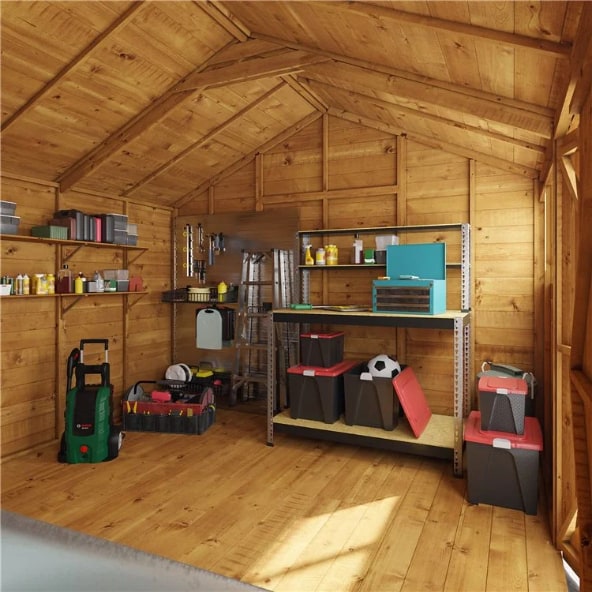
Start your shed workshop transformation by creating a plan. Identify the specific purpose of your workshop and outline the necessary requirements. Will it be for woodworking, crafting, or other activities? Having a clear goal will guide your decisions.
Consider the size and layout of your shed in accordance with your workshop’s intended use. Is the structure big enough to accommodate your needs? Factor in your budget and available space to make informed decisions. A full makeover can be pricey, but utilising upcycled materials can help cut costs. Consider expanding its size, especially if your current shed is too small. However, also see to it that it complements your garden space.
This initial planning phase sets the foundation for a successful and well-organised workshop. Tip: Assess the shed’s current condition. Address any issues before proceeding with enhancements.
2. Decluttering
For an optimal workshop setup, larger sheds are preferable. For one, the generous space can give you lots of options on how you can use the outbuilding. Now, if you’re dealing with a more confined area, decluttering works wonders. Take this opportunity to get rid of miscellaneous items, particularly those unused ones.
Go through each item and keep what’s essential. Also, consider moving everything outside for a clearer workspace. This makes the interior more organised and gives a better view of available space.
3. Electricity and lighting
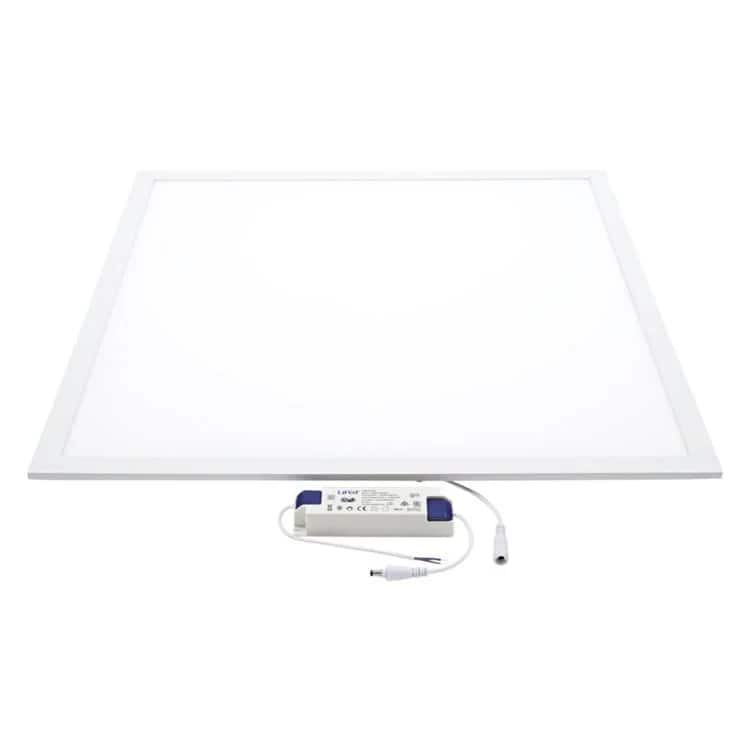
Make sure your shed has good electricity and lighting for a functional workshop. You may hire an electrician for a professional touch or opt for tutorials for a DIY approach. Ensure safety by using outdoor-rated extension cords and outlets. Strategically position power sources for convenient tool access.
Good lighting is important, so place lights well. Opt for alternatives like battery powered lights for sheds to save more down the line. Solar-powered ones are also recommended, as these options are eco-friendly and cost-effective. They’re easy to install without wiring hassles.
4. Work surface setup
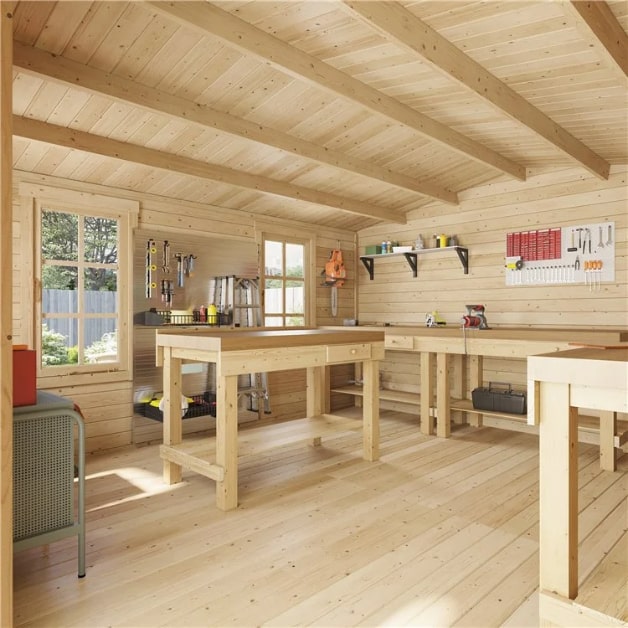
Make your workshop building better by focusing on the main area — the work surface. Ideally, it should be sturdy and big enough to cater to the demands of your projects. Around 3 feet by 6 feet, it can accommodate various works while maintaining stability. Adjust based on your specific needs.
Pick or make a work table with a big and strong top for your projects. Also, design it with storage underneath for your tools and supplies. Keep things organised so you can easily find what you need when you’re working.
Tip: Keep your work table tidy by storing tools in designated areas. This not only creates more space but also protects your tools. Install pegboards or shelves on the walls. A well-planned work area makes your workshop shed efficient and organised.
5. Insulation and heating
Ensuring your workshop is well-insulated is crucial for year-round usability. Consider shed insulation by covering the walls with plasterboard or tongue and groove. These materials provide a basic level of insulation. Additional measures are necessary, however, for optimal warmth during colder seasons.
Explore heating options to create a cosy workspace. Tube heaters, underfloor heating, and portable electric stove heaters offer diverse solutions. Evaluate your local climate conditions to choose the most suitable heating method.
Keep your shed workshop cosy and useful year-round with effective insulation and heating. This makes it a practical space, no matter the weather outside.
6. Extra storage addition
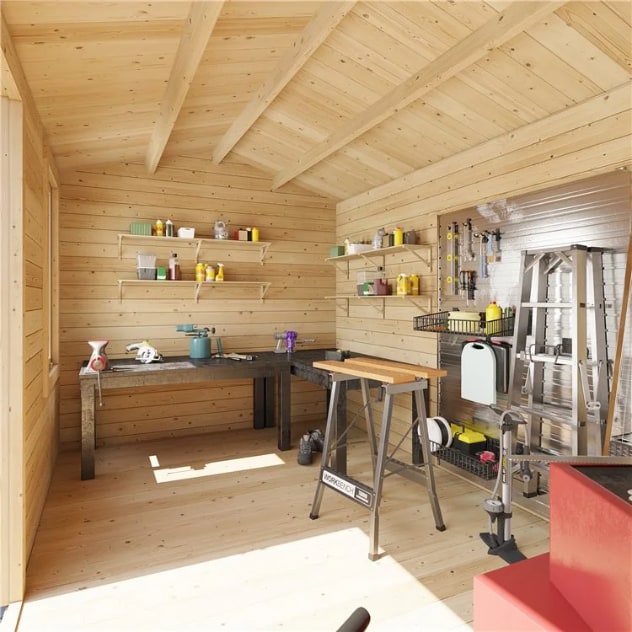
Create a designated space for tools to prevent clutter during your work sessions. Plan storage solutions, such as wooden shelving units, that prioritise safety and accessibility. Store items at heights that are easy to reach when required.
Use pegboards with hooks for small tools to find them easily and keep things organised. Try putting things on the wall to save floor space and tidy your shed workshop. Planning smart storage helps you work better without getting distracted. In return, you can focus on your projects easily.
7. Level the floor
A level surface is essential for a stable workspace. So, make sure the floor is flat and smooth to avoid tripping while you work. Concrete fillers can even out the floor, creating a solid foundation. This not only enhances safety but also ensures accuracy in your projects. Overall, it makes your outdoor workshop more comfortable and efficient.
Remember, uneven floors are not safe and can make your tools and furniture wobbly. Prioritising levelling helps create a comfortable and hazard-free environment. Additionally, it ensures accurate measurements and cuts in woodworking projects. Always the time to address floor irregularities.
8. Create more space for future projects
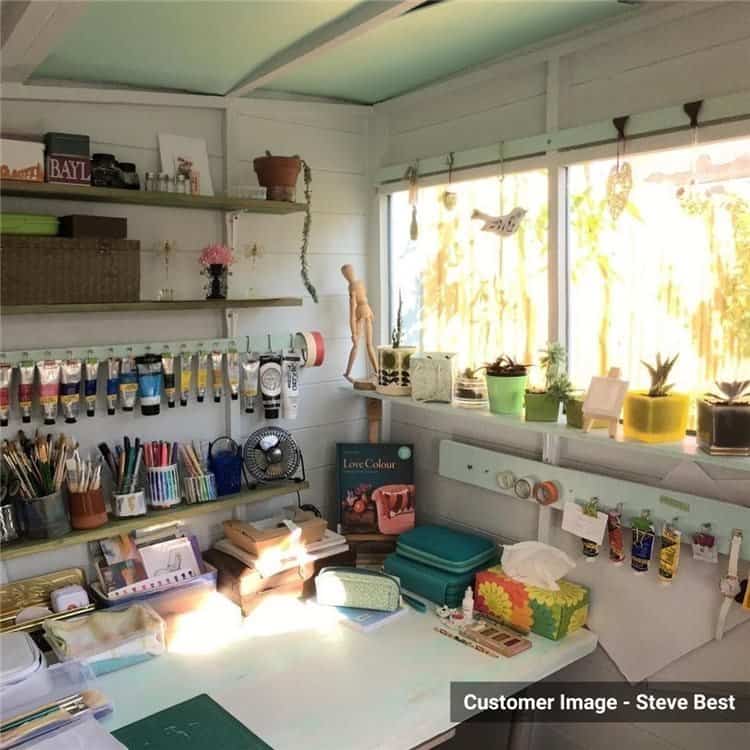
It can be tempting to fill your shed with work surfaces and shelves. This often overwhelms the workshop with clutter, leaving no space for upcoming DIYs. Instead, strategically plan to accommodate new endeavours. Ensure there’s room to spare for creativity and a dynamic workspace.
Think about using storage that can change as you need it. Keep a good balance between tables, shelves, and empty space in your shed workshop. This way, your space won’t feel crowded, and you’ll always have new ideas flowing. A flexible workshop makes crafting enjoyable and productive for current and future projects.
9. Consider rolling work shelving
Make your shed workshop work better by using rolling shelves. They give you extra space when you’re working on projects. When you’re done, you can easily roll them back to save space and keep things neat.
Invest in sturdy, mobile shelving units to enhance flexibility in your workshop layout. When a project demands additional space, simply roll out these shelves. This will give you a temporary work area. Once the task is complete, tuck them back into storage.
To make sure the shelves stay steady when you’re using them, think about adding locks. This helps manage space and adjust your workshop to different project needs easily.
Round-up
By following these steps, your shed can become the perfect garden workshop. Organise, set up a work surface, insulate, add heating, level the floor, and plan for future projects. Consider using rolling shelves for flexibility. With these steps, your shed can become an efficient workshop for all your creative ideas!
Explore Garden Buildings Direct for a range of workshops for sale. Units available come in various sizes and materials, including metal workshops.
Up next on your reading list: Give Your Hobby a Home with a Garden Workshop










